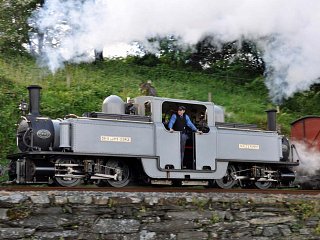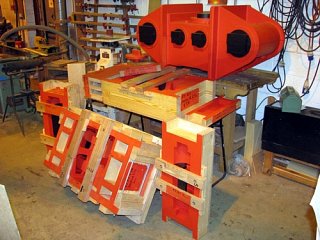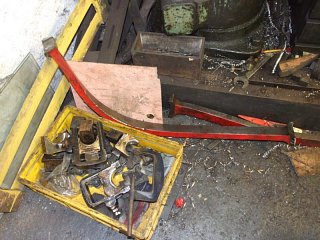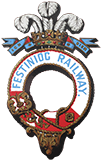Musical Bogies Part III
01 April 2014

As mentioned in the earlier article with respect to Taliesin, the fuel costs had more than doubled in the space of a few years, and so the decision was taken to convert the Earl to coal over the winter 2005-6. The Earl was the logical conclusion (despite having been built as an oil burner) in that the oil tanks were removable, despite the loco shortly becoming due for its ten year inspections.
Following careful calculation of air gaps, casting of firebars, construction of spark arrestors, the Earl successfully hauled its first trains on coal. The only appearance changes were the presence of coal bunkers and ‘greedy boards’ and the introduction of the original ‘square’ dome covers, now painted green. The Earl quickly settled into traffic interchangeably with the other double engines, whilst primary operating costs of operation were half that of oil.
At the end of the season the Earl was dismantled for boiler overhaul which saw the inspection of the throatplates (no problems found), repairs to the inner fireboxes including stay replacements, and the obligatory retubing exercise. The Earl returned to traffic in August 2007 in a temporary black livery with brass dome covers (ex-Merddin) now restored, and regained a new version of the 1989 lined green livery in March 2008 over five weekends.

Earl of Merioneth converted to coal
As the Earl settled into traffic as a coal burner, Merddin Emrys continued in traffic burning oil. It suffered some leakage around the valve faces that hampered its record in service.
Come winter 2006 (check) it was pulled into the works for conversion to coal firing also.
The bogie under Taliesin suffered from damaged valve faces which have been repaired with bolt-on pieces, for which the bolt-on faces suffer blows from time to time. Whilst a piston valve bogie design was considered in the 1970s (see the construction of the Earl with higher tanks clearance) it was always envisaged to be with outside valve gear and a considerable variation from the current practice. Discussions in back rooms assisted by thinking juice resulted in the consideration of building a piston valve layout that would replace the three piece (steamchest and two cylinders) assembly on the current bogies, with a one piece piston valve design; fabricated or cast. Boston Lodge fitter Bob Yates was able to draw the thoughts of many and the design was completed in 2008 –the presence of skilled pattern maker Donald Bateman swung the argument in favour of casting and a pattern was produced. This was ready for the first casting to be made by the end of February 2009.

The monoblock cylinder patterns

New castings for Taliesin in 2009
This casting was machined, and the other necessary parts (piston valves, spindles, glands, covers, etc) manufactured by early 2010. The monobloc, piston valve cylinder and steam chest conversion has been designed to be a ‘bolt in’ replacement for the existing assembly. The valve events were unchanged and the valve gear itself did not require modification.
The virtue of having three double fairlies available was vindicated by the left field hit in April 2008 of leaks from Merddin’s boiler – rivets that attach the domes to the boiler barrel were found to be leaking necessitating an extensive exercise of dismantling and removal of the domes, prior to an agreed repair of replacement of the rivets with bolts.
Returning to traffic again in August 2008 Merddin’s performance has been consistent and provided a good base on which to do scientific testing of the draughting arrangements and valve settings. This involved setting up measurement gear on the TE bogie and smokebox and should be useful in evaluating comparative performance with future developments.

Side rods from Earl of Merioneth
In October 2009, the original rods on the 1987 bogies running under the Earl of Merioneth, suffered a catastrophic failure whilst in traffic. This rendered them beyond further use and new rods were constructed.
Planning started to construct new bogies for DLG
During 2012, Merddin Emrys and Earl of Merioneth shouldered most of the FR mileage, with oil-fired David Lloyd George only running for a handful of days, including the Olympic Torch Relay train. Bogies C and D, whilst near the end of their useful life, had been overhauled to give DLG one more season of running and since that overhaul they had run only a few hundred miles.
With the withdrawal of DLG in early 2013 for its ten year boiler overhaul, it was decided to transfer bogies C and D to Earl of Merioneth to allow overhaul of A and B, both very well worn. This transfer was completed in the winter works programme (click here), effectively reuiniting this incarnation of Earl of Merioneth with the bogies on which it was built (see Musical Bogies Part I).
Bearing in mind that David Lloyd George received a new ten year ‘ticket’ in early 2004, it was withdrawn early as a result of limited use due to the increasing price of oil fuel.
Current status of the existing Fairlie bogies in 2016 is currently:
Bogies A and B – built 1987 (original 1880s wheel centres) – Earl of Merioneth
Bogies C and D – built 1886 – modified 1979 – in storage
Bogie E – completed 1998 – Taliesin
Bogies F and G – completed 2005 – Merddin Emrys
Bogies H and I – completed 2014 – David Lloyd George
Original 1879 Merddin Emrys frames with James Spooner wheels and rods, under Livingston Thompson in York Museum






